Legal Analysis of Copyright and Design Law in Australia: Case Studies
VerifiedAdded on 2023/01/20
|12
|3114
|73
Homework Assignment
AI Summary
This assignment analyzes two legal scenarios under Australian copyright and design law. The first case examines a dispute over the copyright of a remixed song, exploring the concepts of original musical works, copyright ownership (composer vs. lyricist), and potential copyright infringement by a recording company. It delves into how the court would assess originality, authorship, and the validity of copyright claims. The second case focuses on design law, specifically addressing whether the design of a vacuum cleaner is eligible for design registration in Australia. It outlines the criteria for registrability, including the requirements of novelty and distinctiveness, and discusses the factors considered when comparing a design to prior art. The assignment also covers the duration of design protection and the rights of the registered design owner. The analysis highlights the importance of agreements regarding ownership and the legal protections available for both copyright and design.
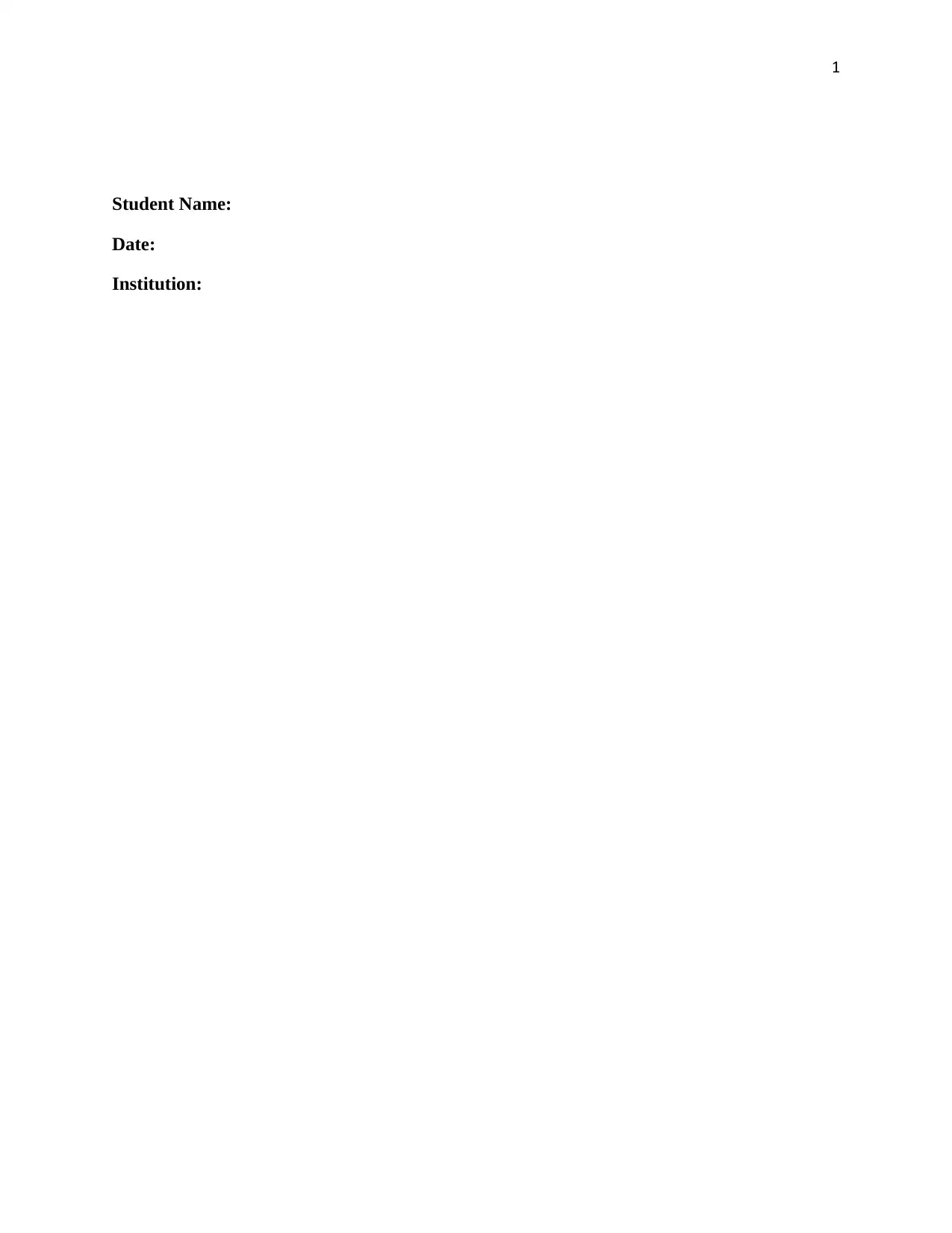
1
Student Name:
Date:
Institution:
Student Name:
Date:
Institution:
Paraphrase This Document
Need a fresh take? Get an instant paraphrase of this document with our AI Paraphraser
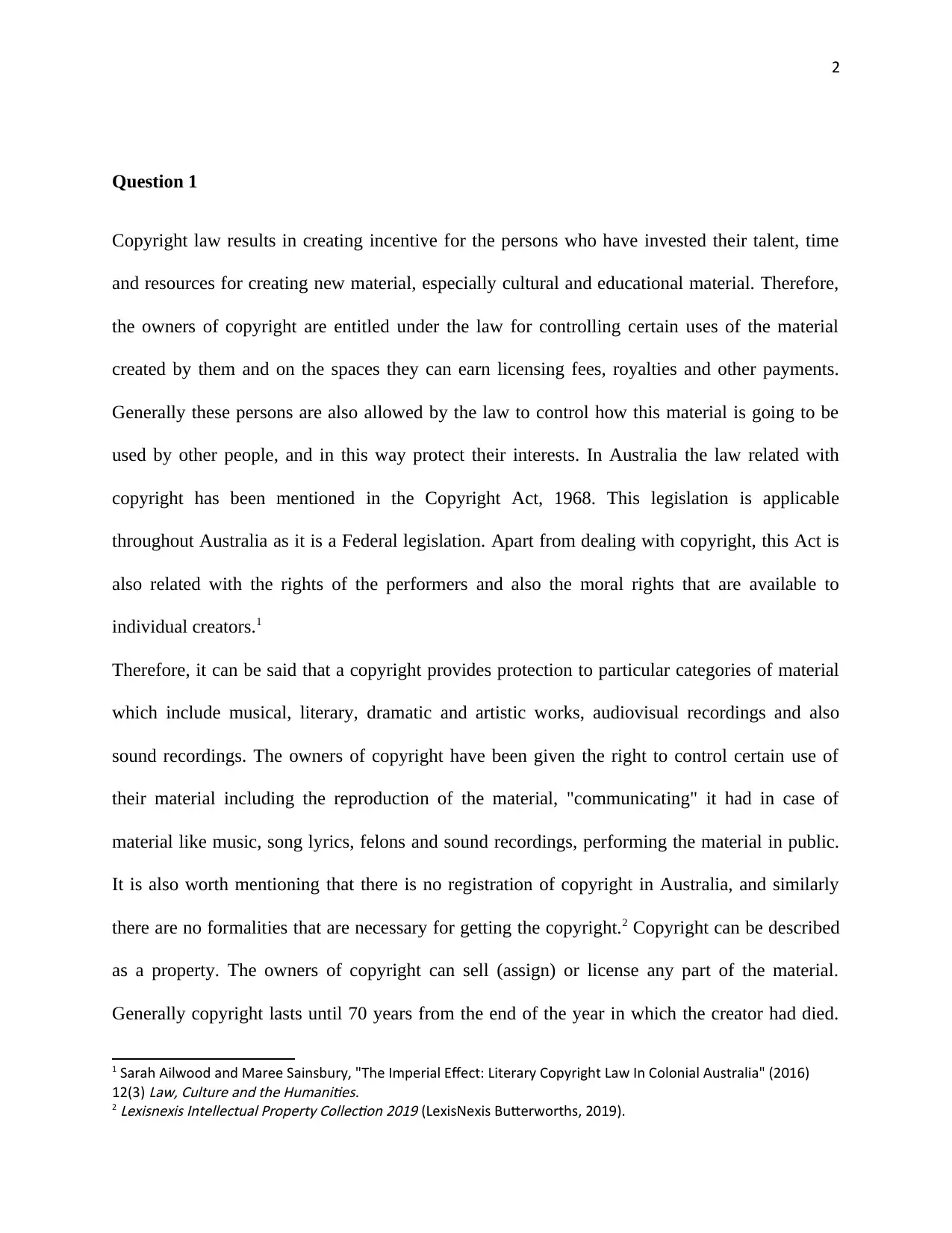
2
Question 1
Copyright law results in creating incentive for the persons who have invested their talent, time
and resources for creating new material, especially cultural and educational material. Therefore,
the owners of copyright are entitled under the law for controlling certain uses of the material
created by them and on the spaces they can earn licensing fees, royalties and other payments.
Generally these persons are also allowed by the law to control how this material is going to be
used by other people, and in this way protect their interests. In Australia the law related with
copyright has been mentioned in the Copyright Act, 1968. This legislation is applicable
throughout Australia as it is a Federal legislation. Apart from dealing with copyright, this Act is
also related with the rights of the performers and also the moral rights that are available to
individual creators.1
Therefore, it can be said that a copyright provides protection to particular categories of material
which include musical, literary, dramatic and artistic works, audiovisual recordings and also
sound recordings. The owners of copyright have been given the right to control certain use of
their material including the reproduction of the material, "communicating" it had in case of
material like music, song lyrics, felons and sound recordings, performing the material in public.
It is also worth mentioning that there is no registration of copyright in Australia, and similarly
there are no formalities that are necessary for getting the copyright.2 Copyright can be described
as a property. The owners of copyright can sell (assign) or license any part of the material.
Generally copyright lasts until 70 years from the end of the year in which the creator had died.
1 Sarah Ailwood and Maree Sainsbury, "The Imperial Effect: Literary Copyright Law In Colonial Australia" (2016)
12(3)
Law, Culture and the Humanities.
2
Lexisnexis Intellectual Property Collection 2019 (LexisNexis Butterworths, 2019).
Question 1
Copyright law results in creating incentive for the persons who have invested their talent, time
and resources for creating new material, especially cultural and educational material. Therefore,
the owners of copyright are entitled under the law for controlling certain uses of the material
created by them and on the spaces they can earn licensing fees, royalties and other payments.
Generally these persons are also allowed by the law to control how this material is going to be
used by other people, and in this way protect their interests. In Australia the law related with
copyright has been mentioned in the Copyright Act, 1968. This legislation is applicable
throughout Australia as it is a Federal legislation. Apart from dealing with copyright, this Act is
also related with the rights of the performers and also the moral rights that are available to
individual creators.1
Therefore, it can be said that a copyright provides protection to particular categories of material
which include musical, literary, dramatic and artistic works, audiovisual recordings and also
sound recordings. The owners of copyright have been given the right to control certain use of
their material including the reproduction of the material, "communicating" it had in case of
material like music, song lyrics, felons and sound recordings, performing the material in public.
It is also worth mentioning that there is no registration of copyright in Australia, and similarly
there are no formalities that are necessary for getting the copyright.2 Copyright can be described
as a property. The owners of copyright can sell (assign) or license any part of the material.
Generally copyright lasts until 70 years from the end of the year in which the creator had died.
1 Sarah Ailwood and Maree Sainsbury, "The Imperial Effect: Literary Copyright Law In Colonial Australia" (2016)
12(3)
Law, Culture and the Humanities.
2
Lexisnexis Intellectual Property Collection 2019 (LexisNexis Butterworths, 2019).
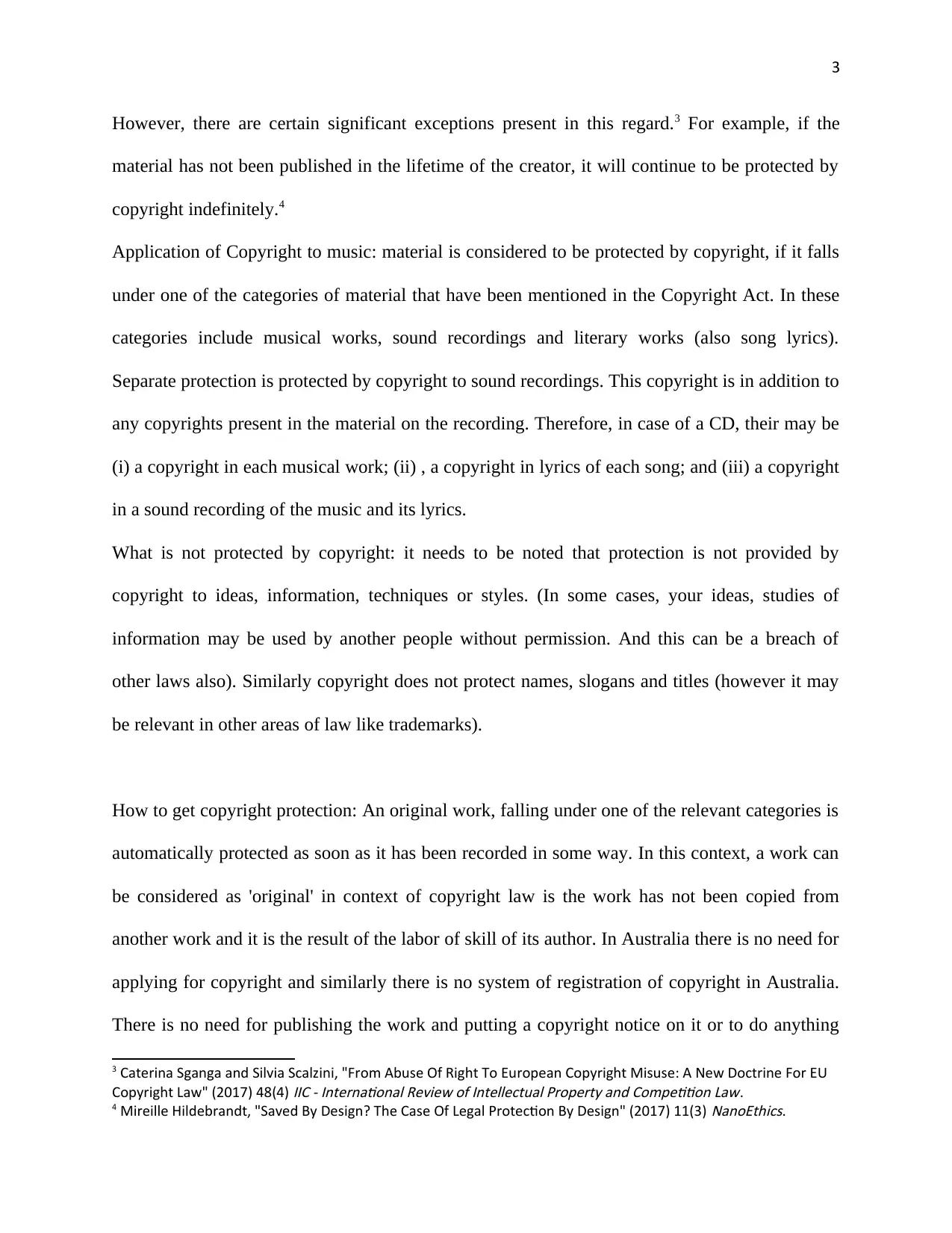
3
However, there are certain significant exceptions present in this regard.3 For example, if the
material has not been published in the lifetime of the creator, it will continue to be protected by
copyright indefinitely.4
Application of Copyright to music: material is considered to be protected by copyright, if it falls
under one of the categories of material that have been mentioned in the Copyright Act. In these
categories include musical works, sound recordings and literary works (also song lyrics).
Separate protection is protected by copyright to sound recordings. This copyright is in addition to
any copyrights present in the material on the recording. Therefore, in case of a CD, their may be
(i) a copyright in each musical work; (ii) , a copyright in lyrics of each song; and (iii) a copyright
in a sound recording of the music and its lyrics.
What is not protected by copyright: it needs to be noted that protection is not provided by
copyright to ideas, information, techniques or styles. (In some cases, your ideas, studies of
information may be used by another people without permission. And this can be a breach of
other laws also). Similarly copyright does not protect names, slogans and titles (however it may
be relevant in other areas of law like trademarks).
How to get copyright protection: An original work, falling under one of the relevant categories is
automatically protected as soon as it has been recorded in some way. In this context, a work can
be considered as 'original' in context of copyright law is the work has not been copied from
another work and it is the result of the labor of skill of its author. In Australia there is no need for
applying for copyright and similarly there is no system of registration of copyright in Australia.
There is no need for publishing the work and putting a copyright notice on it or to do anything
3 Caterina Sganga and Silvia Scalzini, "From Abuse Of Right To European Copyright Misuse: A New Doctrine For EU
Copyright Law" (2017) 48(4)
IIC - International Review of Intellectual Property and Competition Law.
4 Mireille Hildebrandt, "Saved By Design? The Case Of Legal Protection By Design" (2017) 11(3)
NanoEthics.
However, there are certain significant exceptions present in this regard.3 For example, if the
material has not been published in the lifetime of the creator, it will continue to be protected by
copyright indefinitely.4
Application of Copyright to music: material is considered to be protected by copyright, if it falls
under one of the categories of material that have been mentioned in the Copyright Act. In these
categories include musical works, sound recordings and literary works (also song lyrics).
Separate protection is protected by copyright to sound recordings. This copyright is in addition to
any copyrights present in the material on the recording. Therefore, in case of a CD, their may be
(i) a copyright in each musical work; (ii) , a copyright in lyrics of each song; and (iii) a copyright
in a sound recording of the music and its lyrics.
What is not protected by copyright: it needs to be noted that protection is not provided by
copyright to ideas, information, techniques or styles. (In some cases, your ideas, studies of
information may be used by another people without permission. And this can be a breach of
other laws also). Similarly copyright does not protect names, slogans and titles (however it may
be relevant in other areas of law like trademarks).
How to get copyright protection: An original work, falling under one of the relevant categories is
automatically protected as soon as it has been recorded in some way. In this context, a work can
be considered as 'original' in context of copyright law is the work has not been copied from
another work and it is the result of the labor of skill of its author. In Australia there is no need for
applying for copyright and similarly there is no system of registration of copyright in Australia.
There is no need for publishing the work and putting a copyright notice on it or to do anything
3 Caterina Sganga and Silvia Scalzini, "From Abuse Of Right To European Copyright Misuse: A New Doctrine For EU
Copyright Law" (2017) 48(4)
IIC - International Review of Intellectual Property and Competition Law.
4 Mireille Hildebrandt, "Saved By Design? The Case Of Legal Protection By Design" (2017) 11(3)
NanoEthics.
⊘ This is a preview!⊘
Do you want full access?
Subscribe today to unlock all pages.

Trusted by 1+ million students worldwide
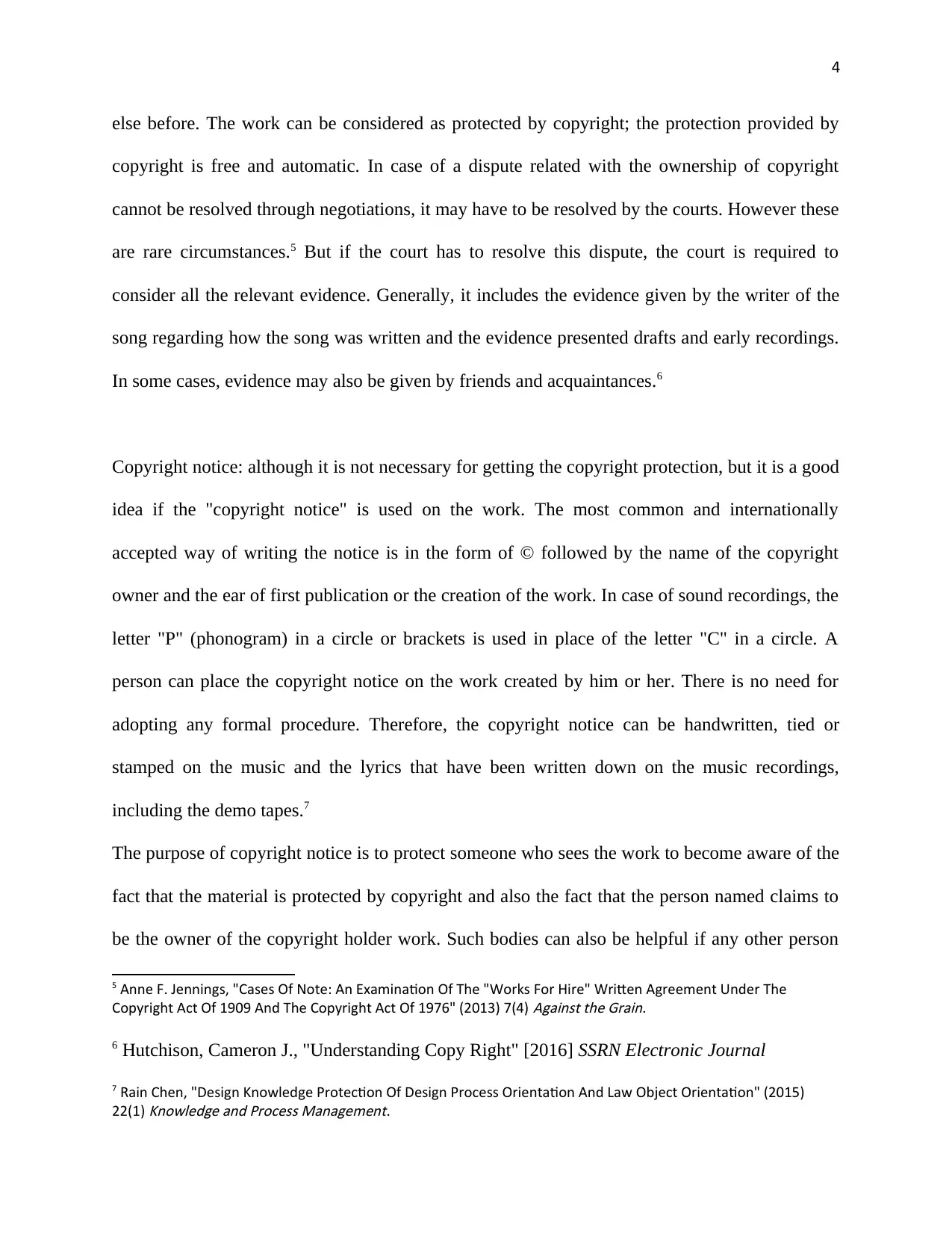
4
else before. The work can be considered as protected by copyright; the protection provided by
copyright is free and automatic. In case of a dispute related with the ownership of copyright
cannot be resolved through negotiations, it may have to be resolved by the courts. However these
are rare circumstances.5 But if the court has to resolve this dispute, the court is required to
consider all the relevant evidence. Generally, it includes the evidence given by the writer of the
song regarding how the song was written and the evidence presented drafts and early recordings.
In some cases, evidence may also be given by friends and acquaintances.6
Copyright notice: although it is not necessary for getting the copyright protection, but it is a good
idea if the "copyright notice" is used on the work. The most common and internationally
accepted way of writing the notice is in the form of © followed by the name of the copyright
owner and the ear of first publication or the creation of the work. In case of sound recordings, the
letter "P" (phonogram) in a circle or brackets is used in place of the letter "C" in a circle. A
person can place the copyright notice on the work created by him or her. There is no need for
adopting any formal procedure. Therefore, the copyright notice can be handwritten, tied or
stamped on the music and the lyrics that have been written down on the music recordings,
including the demo tapes.7
The purpose of copyright notice is to protect someone who sees the work to become aware of the
fact that the material is protected by copyright and also the fact that the person named claims to
be the owner of the copyright holder work. Such bodies can also be helpful if any other person
5 Anne F. Jennings, "Cases Of Note: An Examination Of The "Works For Hire" Written Agreement Under The
Copyright Act Of 1909 And The Copyright Act Of 1976" (2013) 7(4)
Against the Grain.
6 Hutchison, Cameron J., "Understanding Copy Right" [2016] SSRN Electronic Journal
7 Rain Chen, "Design Knowledge Protection Of Design Process Orientation And Law Object Orientation" (2015)
22(1)
Knowledge and Process Management.
else before. The work can be considered as protected by copyright; the protection provided by
copyright is free and automatic. In case of a dispute related with the ownership of copyright
cannot be resolved through negotiations, it may have to be resolved by the courts. However these
are rare circumstances.5 But if the court has to resolve this dispute, the court is required to
consider all the relevant evidence. Generally, it includes the evidence given by the writer of the
song regarding how the song was written and the evidence presented drafts and early recordings.
In some cases, evidence may also be given by friends and acquaintances.6
Copyright notice: although it is not necessary for getting the copyright protection, but it is a good
idea if the "copyright notice" is used on the work. The most common and internationally
accepted way of writing the notice is in the form of © followed by the name of the copyright
owner and the ear of first publication or the creation of the work. In case of sound recordings, the
letter "P" (phonogram) in a circle or brackets is used in place of the letter "C" in a circle. A
person can place the copyright notice on the work created by him or her. There is no need for
adopting any formal procedure. Therefore, the copyright notice can be handwritten, tied or
stamped on the music and the lyrics that have been written down on the music recordings,
including the demo tapes.7
The purpose of copyright notice is to protect someone who sees the work to become aware of the
fact that the material is protected by copyright and also the fact that the person named claims to
be the owner of the copyright holder work. Such bodies can also be helpful if any other person
5 Anne F. Jennings, "Cases Of Note: An Examination Of The "Works For Hire" Written Agreement Under The
Copyright Act Of 1909 And The Copyright Act Of 1976" (2013) 7(4)
Against the Grain.
6 Hutchison, Cameron J., "Understanding Copy Right" [2016] SSRN Electronic Journal
7 Rain Chen, "Design Knowledge Protection Of Design Process Orientation And Law Object Orientation" (2015)
22(1)
Knowledge and Process Management.
Paraphrase This Document
Need a fresh take? Get an instant paraphrase of this document with our AI Paraphraser
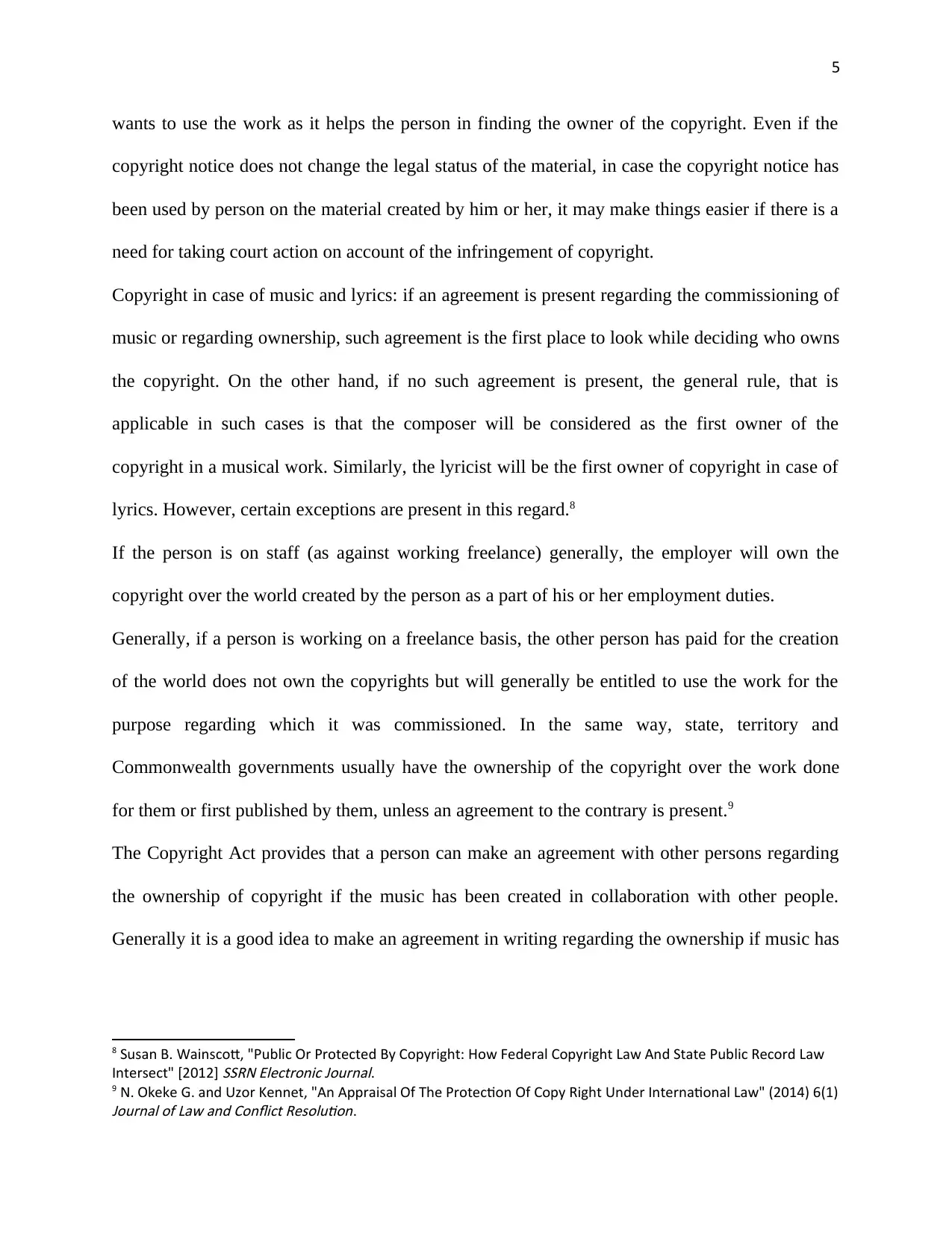
5
wants to use the work as it helps the person in finding the owner of the copyright. Even if the
copyright notice does not change the legal status of the material, in case the copyright notice has
been used by person on the material created by him or her, it may make things easier if there is a
need for taking court action on account of the infringement of copyright.
Copyright in case of music and lyrics: if an agreement is present regarding the commissioning of
music or regarding ownership, such agreement is the first place to look while deciding who owns
the copyright. On the other hand, if no such agreement is present, the general rule, that is
applicable in such cases is that the composer will be considered as the first owner of the
copyright in a musical work. Similarly, the lyricist will be the first owner of copyright in case of
lyrics. However, certain exceptions are present in this regard.8
If the person is on staff (as against working freelance) generally, the employer will own the
copyright over the world created by the person as a part of his or her employment duties.
Generally, if a person is working on a freelance basis, the other person has paid for the creation
of the world does not own the copyrights but will generally be entitled to use the work for the
purpose regarding which it was commissioned. In the same way, state, territory and
Commonwealth governments usually have the ownership of the copyright over the work done
for them or first published by them, unless an agreement to the contrary is present.9
The Copyright Act provides that a person can make an agreement with other persons regarding
the ownership of copyright if the music has been created in collaboration with other people.
Generally it is a good idea to make an agreement in writing regarding the ownership if music has
8 Susan B. Wainscott, "Public Or Protected By Copyright: How Federal Copyright Law And State Public Record Law
Intersect" [2012]
SSRN Electronic Journal.
9 N. Okeke G. and Uzor Kennet, "An Appraisal Of The Protection Of Copy Right Under International Law" (2014) 6(1)
Journal of Law and Conflict Resolution.
wants to use the work as it helps the person in finding the owner of the copyright. Even if the
copyright notice does not change the legal status of the material, in case the copyright notice has
been used by person on the material created by him or her, it may make things easier if there is a
need for taking court action on account of the infringement of copyright.
Copyright in case of music and lyrics: if an agreement is present regarding the commissioning of
music or regarding ownership, such agreement is the first place to look while deciding who owns
the copyright. On the other hand, if no such agreement is present, the general rule, that is
applicable in such cases is that the composer will be considered as the first owner of the
copyright in a musical work. Similarly, the lyricist will be the first owner of copyright in case of
lyrics. However, certain exceptions are present in this regard.8
If the person is on staff (as against working freelance) generally, the employer will own the
copyright over the world created by the person as a part of his or her employment duties.
Generally, if a person is working on a freelance basis, the other person has paid for the creation
of the world does not own the copyrights but will generally be entitled to use the work for the
purpose regarding which it was commissioned. In the same way, state, territory and
Commonwealth governments usually have the ownership of the copyright over the work done
for them or first published by them, unless an agreement to the contrary is present.9
The Copyright Act provides that a person can make an agreement with other persons regarding
the ownership of copyright if the music has been created in collaboration with other people.
Generally it is a good idea to make an agreement in writing regarding the ownership if music has
8 Susan B. Wainscott, "Public Or Protected By Copyright: How Federal Copyright Law And State Public Record Law
Intersect" [2012]
SSRN Electronic Journal.
9 N. Okeke G. and Uzor Kennet, "An Appraisal Of The Protection Of Copy Right Under International Law" (2014) 6(1)
Journal of Law and Conflict Resolution.
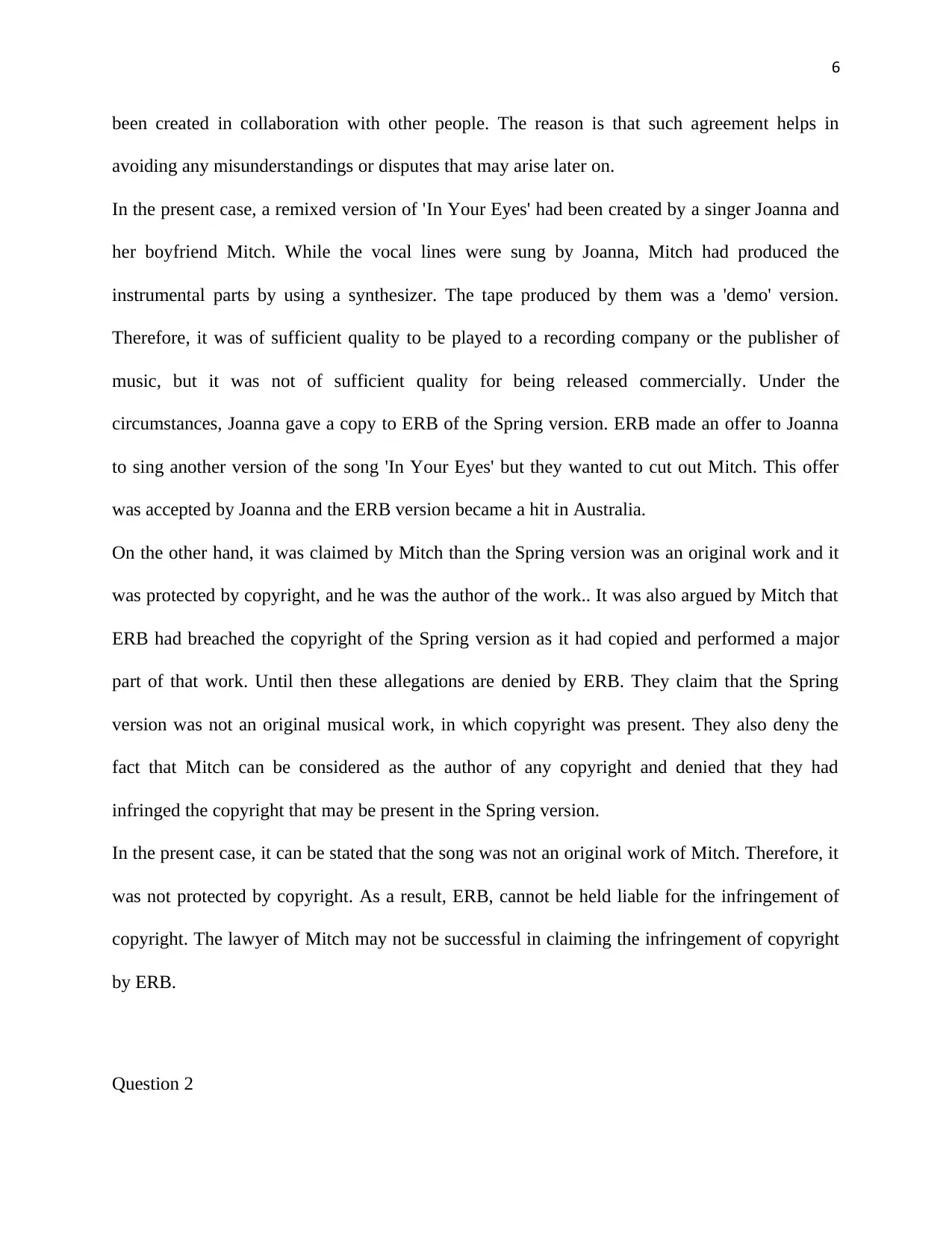
6
been created in collaboration with other people. The reason is that such agreement helps in
avoiding any misunderstandings or disputes that may arise later on.
In the present case, a remixed version of 'In Your Eyes' had been created by a singer Joanna and
her boyfriend Mitch. While the vocal lines were sung by Joanna, Mitch had produced the
instrumental parts by using a synthesizer. The tape produced by them was a 'demo' version.
Therefore, it was of sufficient quality to be played to a recording company or the publisher of
music, but it was not of sufficient quality for being released commercially. Under the
circumstances, Joanna gave a copy to ERB of the Spring version. ERB made an offer to Joanna
to sing another version of the song 'In Your Eyes' but they wanted to cut out Mitch. This offer
was accepted by Joanna and the ERB version became a hit in Australia.
On the other hand, it was claimed by Mitch than the Spring version was an original work and it
was protected by copyright, and he was the author of the work.. It was also argued by Mitch that
ERB had breached the copyright of the Spring version as it had copied and performed a major
part of that work. Until then these allegations are denied by ERB. They claim that the Spring
version was not an original musical work, in which copyright was present. They also deny the
fact that Mitch can be considered as the author of any copyright and denied that they had
infringed the copyright that may be present in the Spring version.
In the present case, it can be stated that the song was not an original work of Mitch. Therefore, it
was not protected by copyright. As a result, ERB, cannot be held liable for the infringement of
copyright. The lawyer of Mitch may not be successful in claiming the infringement of copyright
by ERB.
Question 2
been created in collaboration with other people. The reason is that such agreement helps in
avoiding any misunderstandings or disputes that may arise later on.
In the present case, a remixed version of 'In Your Eyes' had been created by a singer Joanna and
her boyfriend Mitch. While the vocal lines were sung by Joanna, Mitch had produced the
instrumental parts by using a synthesizer. The tape produced by them was a 'demo' version.
Therefore, it was of sufficient quality to be played to a recording company or the publisher of
music, but it was not of sufficient quality for being released commercially. Under the
circumstances, Joanna gave a copy to ERB of the Spring version. ERB made an offer to Joanna
to sing another version of the song 'In Your Eyes' but they wanted to cut out Mitch. This offer
was accepted by Joanna and the ERB version became a hit in Australia.
On the other hand, it was claimed by Mitch than the Spring version was an original work and it
was protected by copyright, and he was the author of the work.. It was also argued by Mitch that
ERB had breached the copyright of the Spring version as it had copied and performed a major
part of that work. Until then these allegations are denied by ERB. They claim that the Spring
version was not an original musical work, in which copyright was present. They also deny the
fact that Mitch can be considered as the author of any copyright and denied that they had
infringed the copyright that may be present in the Spring version.
In the present case, it can be stated that the song was not an original work of Mitch. Therefore, it
was not protected by copyright. As a result, ERB, cannot be held liable for the infringement of
copyright. The lawyer of Mitch may not be successful in claiming the infringement of copyright
by ERB.
Question 2
⊘ This is a preview!⊘
Do you want full access?
Subscribe today to unlock all pages.

Trusted by 1+ million students worldwide
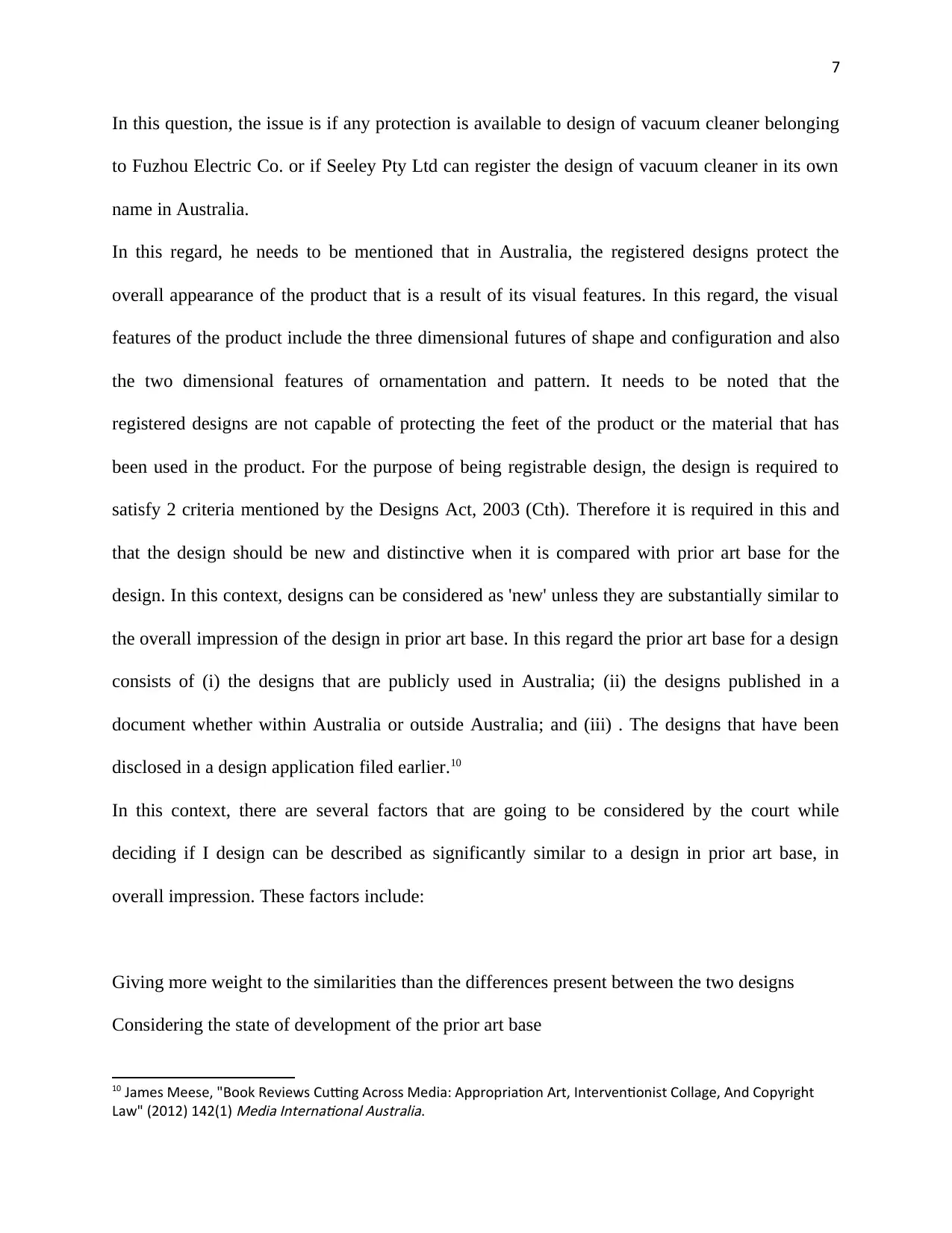
7
In this question, the issue is if any protection is available to design of vacuum cleaner belonging
to Fuzhou Electric Co. or if Seeley Pty Ltd can register the design of vacuum cleaner in its own
name in Australia.
In this regard, he needs to be mentioned that in Australia, the registered designs protect the
overall appearance of the product that is a result of its visual features. In this regard, the visual
features of the product include the three dimensional futures of shape and configuration and also
the two dimensional features of ornamentation and pattern. It needs to be noted that the
registered designs are not capable of protecting the feet of the product or the material that has
been used in the product. For the purpose of being registrable design, the design is required to
satisfy 2 criteria mentioned by the Designs Act, 2003 (Cth). Therefore it is required in this and
that the design should be new and distinctive when it is compared with prior art base for the
design. In this context, designs can be considered as 'new' unless they are substantially similar to
the overall impression of the design in prior art base. In this regard the prior art base for a design
consists of (i) the designs that are publicly used in Australia; (ii) the designs published in a
document whether within Australia or outside Australia; and (iii) . The designs that have been
disclosed in a design application filed earlier.10
In this context, there are several factors that are going to be considered by the court while
deciding if I design can be described as significantly similar to a design in prior art base, in
overall impression. These factors include:
Giving more weight to the similarities than the differences present between the two designs
Considering the state of development of the prior art base
10 James Meese, "Book Reviews Cutting Across Media: Appropriation Art, Interventionist Collage, And Copyright
Law" (2012) 142(1)
Media International Australia.
In this question, the issue is if any protection is available to design of vacuum cleaner belonging
to Fuzhou Electric Co. or if Seeley Pty Ltd can register the design of vacuum cleaner in its own
name in Australia.
In this regard, he needs to be mentioned that in Australia, the registered designs protect the
overall appearance of the product that is a result of its visual features. In this regard, the visual
features of the product include the three dimensional futures of shape and configuration and also
the two dimensional features of ornamentation and pattern. It needs to be noted that the
registered designs are not capable of protecting the feet of the product or the material that has
been used in the product. For the purpose of being registrable design, the design is required to
satisfy 2 criteria mentioned by the Designs Act, 2003 (Cth). Therefore it is required in this and
that the design should be new and distinctive when it is compared with prior art base for the
design. In this context, designs can be considered as 'new' unless they are substantially similar to
the overall impression of the design in prior art base. In this regard the prior art base for a design
consists of (i) the designs that are publicly used in Australia; (ii) the designs published in a
document whether within Australia or outside Australia; and (iii) . The designs that have been
disclosed in a design application filed earlier.10
In this context, there are several factors that are going to be considered by the court while
deciding if I design can be described as significantly similar to a design in prior art base, in
overall impression. These factors include:
Giving more weight to the similarities than the differences present between the two designs
Considering the state of development of the prior art base
10 James Meese, "Book Reviews Cutting Across Media: Appropriation Art, Interventionist Collage, And Copyright
Law" (2012) 142(1)
Media International Australia.
Paraphrase This Document
Need a fresh take? Get an instant paraphrase of this document with our AI Paraphraser
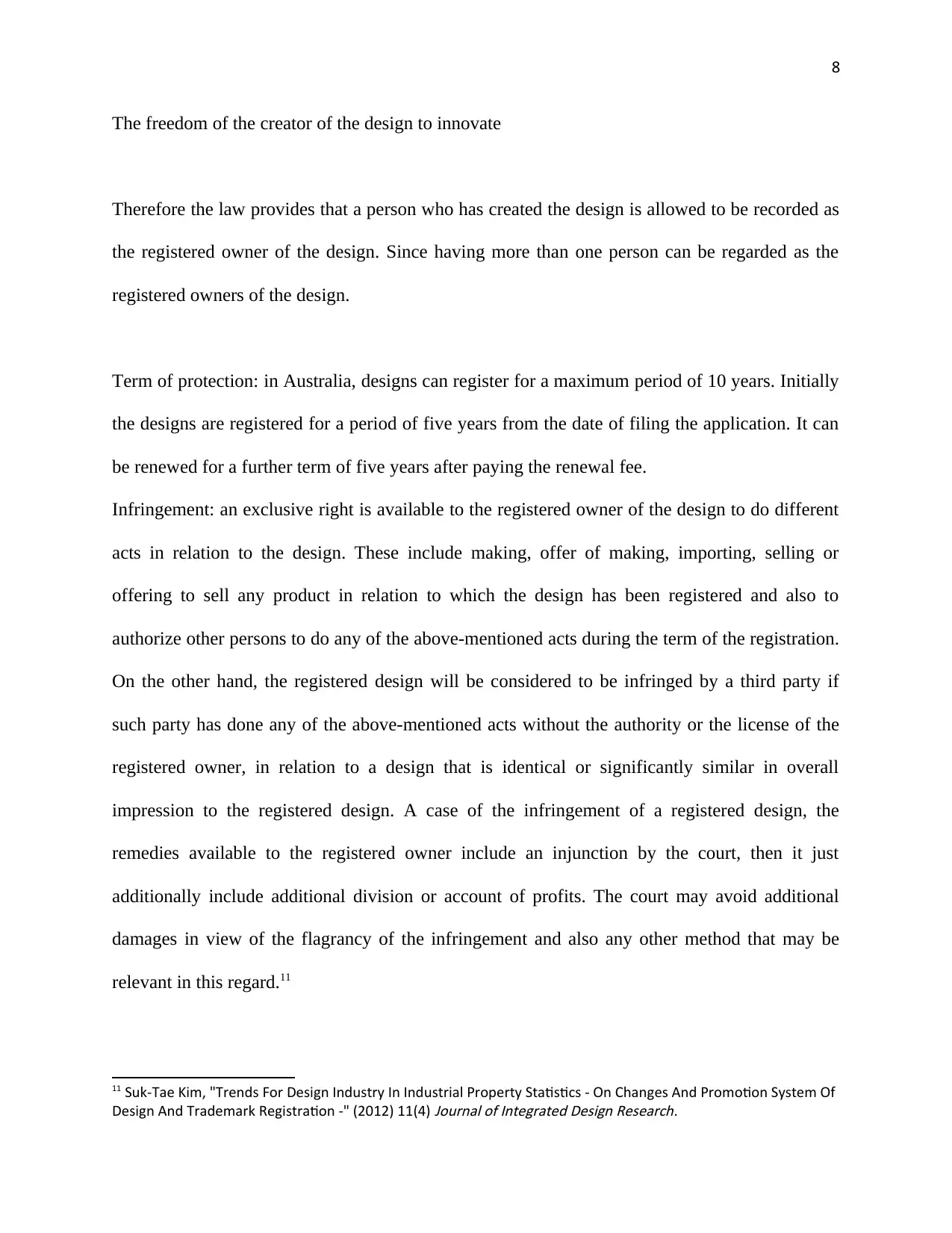
8
The freedom of the creator of the design to innovate
Therefore the law provides that a person who has created the design is allowed to be recorded as
the registered owner of the design. Since having more than one person can be regarded as the
registered owners of the design.
Term of protection: in Australia, designs can register for a maximum period of 10 years. Initially
the designs are registered for a period of five years from the date of filing the application. It can
be renewed for a further term of five years after paying the renewal fee.
Infringement: an exclusive right is available to the registered owner of the design to do different
acts in relation to the design. These include making, offer of making, importing, selling or
offering to sell any product in relation to which the design has been registered and also to
authorize other persons to do any of the above-mentioned acts during the term of the registration.
On the other hand, the registered design will be considered to be infringed by a third party if
such party has done any of the above-mentioned acts without the authority or the license of the
registered owner, in relation to a design that is identical or significantly similar in overall
impression to the registered design. A case of the infringement of a registered design, the
remedies available to the registered owner include an injunction by the court, then it just
additionally include additional division or account of profits. The court may avoid additional
damages in view of the flagrancy of the infringement and also any other method that may be
relevant in this regard.11
11 Suk-Tae Kim, "Trends For Design Industry In Industrial Property Statistics - On Changes And Promotion System Of
Design And Trademark Registration -" (2012) 11(4)
Journal of Integrated Design Research.
The freedom of the creator of the design to innovate
Therefore the law provides that a person who has created the design is allowed to be recorded as
the registered owner of the design. Since having more than one person can be regarded as the
registered owners of the design.
Term of protection: in Australia, designs can register for a maximum period of 10 years. Initially
the designs are registered for a period of five years from the date of filing the application. It can
be renewed for a further term of five years after paying the renewal fee.
Infringement: an exclusive right is available to the registered owner of the design to do different
acts in relation to the design. These include making, offer of making, importing, selling or
offering to sell any product in relation to which the design has been registered and also to
authorize other persons to do any of the above-mentioned acts during the term of the registration.
On the other hand, the registered design will be considered to be infringed by a third party if
such party has done any of the above-mentioned acts without the authority or the license of the
registered owner, in relation to a design that is identical or significantly similar in overall
impression to the registered design. A case of the infringement of a registered design, the
remedies available to the registered owner include an injunction by the court, then it just
additionally include additional division or account of profits. The court may avoid additional
damages in view of the flagrancy of the infringement and also any other method that may be
relevant in this regard.11
11 Suk-Tae Kim, "Trends For Design Industry In Industrial Property Statistics - On Changes And Promotion System Of
Design And Trademark Registration -" (2012) 11(4)
Journal of Integrated Design Research.
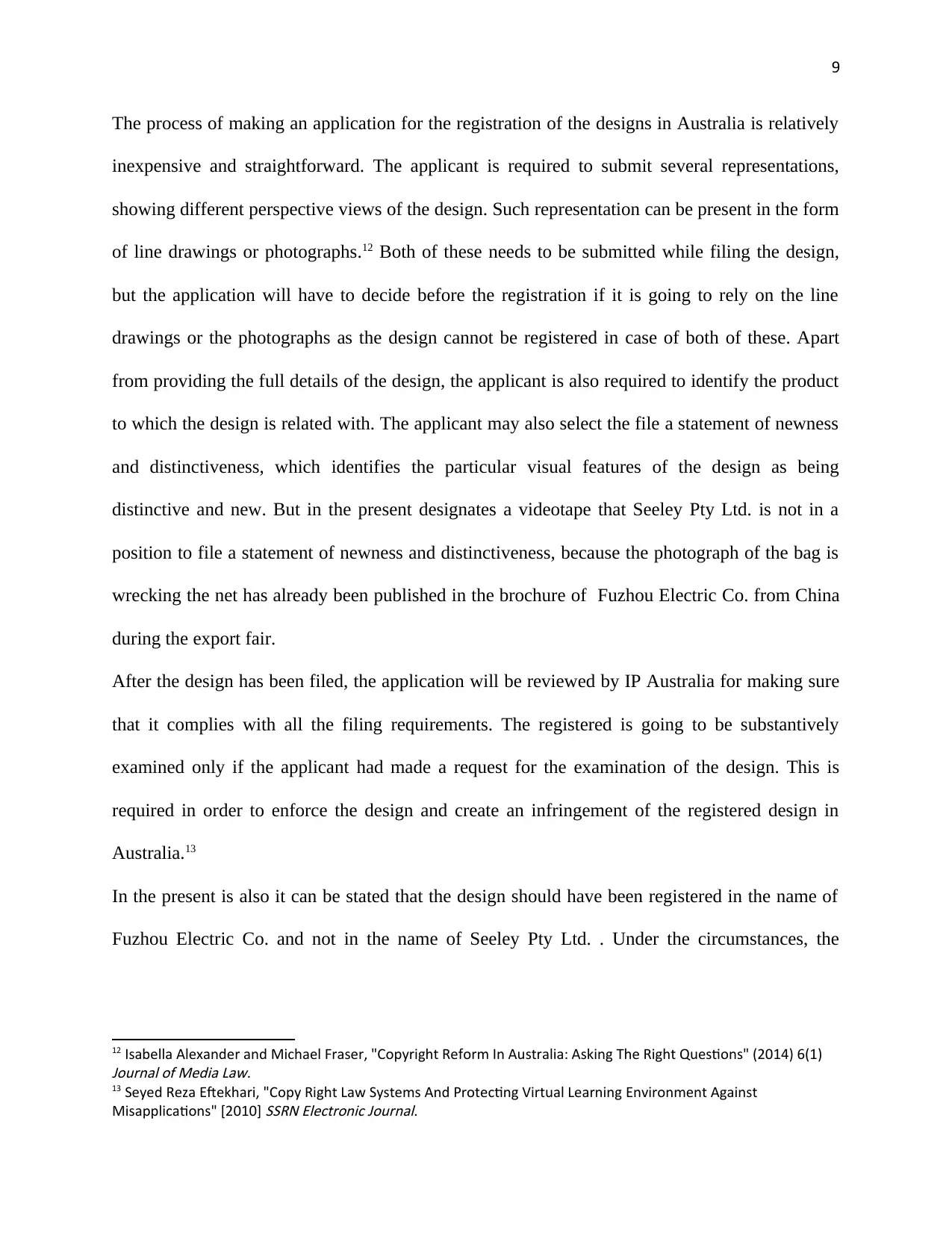
9
The process of making an application for the registration of the designs in Australia is relatively
inexpensive and straightforward. The applicant is required to submit several representations,
showing different perspective views of the design. Such representation can be present in the form
of line drawings or photographs.12 Both of these needs to be submitted while filing the design,
but the application will have to decide before the registration if it is going to rely on the line
drawings or the photographs as the design cannot be registered in case of both of these. Apart
from providing the full details of the design, the applicant is also required to identify the product
to which the design is related with. The applicant may also select the file a statement of newness
and distinctiveness, which identifies the particular visual features of the design as being
distinctive and new. But in the present designates a videotape that Seeley Pty Ltd. is not in a
position to file a statement of newness and distinctiveness, because the photograph of the bag is
wrecking the net has already been published in the brochure of Fuzhou Electric Co. from China
during the export fair.
After the design has been filed, the application will be reviewed by IP Australia for making sure
that it complies with all the filing requirements. The registered is going to be substantively
examined only if the applicant had made a request for the examination of the design. This is
required in order to enforce the design and create an infringement of the registered design in
Australia.13
In the present is also it can be stated that the design should have been registered in the name of
Fuzhou Electric Co. and not in the name of Seeley Pty Ltd. . Under the circumstances, the
12 Isabella Alexander and Michael Fraser, "Copyright Reform In Australia: Asking The Right Questions" (2014) 6(1)
Journal of Media Law.
13 Seyed Reza Eftekhari, "Copy Right Law Systems And Protecting Virtual Learning Environment Against
Misapplications" [2010]
SSRN Electronic Journal.
The process of making an application for the registration of the designs in Australia is relatively
inexpensive and straightforward. The applicant is required to submit several representations,
showing different perspective views of the design. Such representation can be present in the form
of line drawings or photographs.12 Both of these needs to be submitted while filing the design,
but the application will have to decide before the registration if it is going to rely on the line
drawings or the photographs as the design cannot be registered in case of both of these. Apart
from providing the full details of the design, the applicant is also required to identify the product
to which the design is related with. The applicant may also select the file a statement of newness
and distinctiveness, which identifies the particular visual features of the design as being
distinctive and new. But in the present designates a videotape that Seeley Pty Ltd. is not in a
position to file a statement of newness and distinctiveness, because the photograph of the bag is
wrecking the net has already been published in the brochure of Fuzhou Electric Co. from China
during the export fair.
After the design has been filed, the application will be reviewed by IP Australia for making sure
that it complies with all the filing requirements. The registered is going to be substantively
examined only if the applicant had made a request for the examination of the design. This is
required in order to enforce the design and create an infringement of the registered design in
Australia.13
In the present is also it can be stated that the design should have been registered in the name of
Fuzhou Electric Co. and not in the name of Seeley Pty Ltd. . Under the circumstances, the
12 Isabella Alexander and Michael Fraser, "Copyright Reform In Australia: Asking The Right Questions" (2014) 6(1)
Journal of Media Law.
13 Seyed Reza Eftekhari, "Copy Right Law Systems And Protecting Virtual Learning Environment Against
Misapplications" [2010]
SSRN Electronic Journal.
⊘ This is a preview!⊘
Do you want full access?
Subscribe today to unlock all pages.

Trusted by 1+ million students worldwide
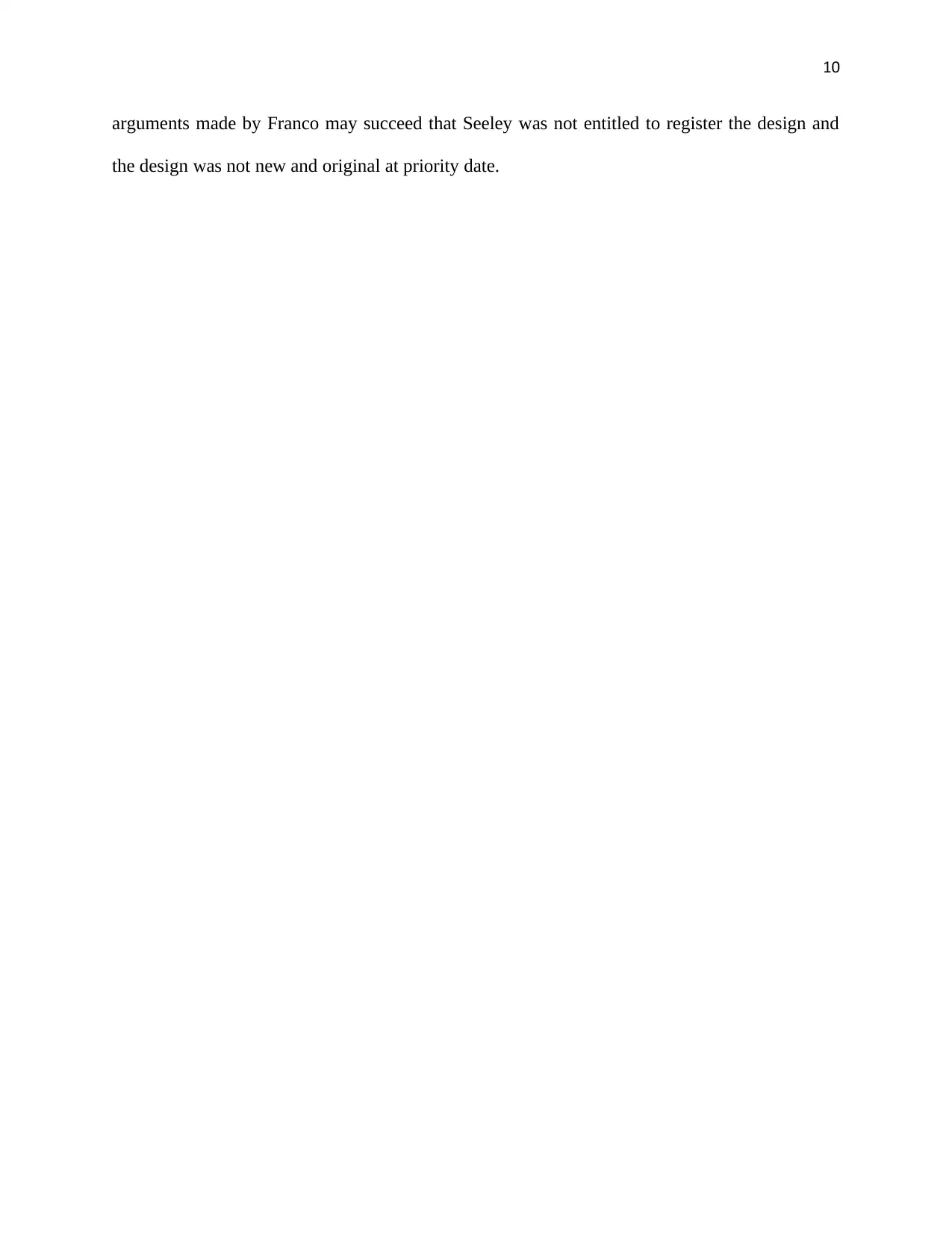
10
arguments made by Franco may succeed that Seeley was not entitled to register the design and
the design was not new and original at priority date.
arguments made by Franco may succeed that Seeley was not entitled to register the design and
the design was not new and original at priority date.
Paraphrase This Document
Need a fresh take? Get an instant paraphrase of this document with our AI Paraphraser
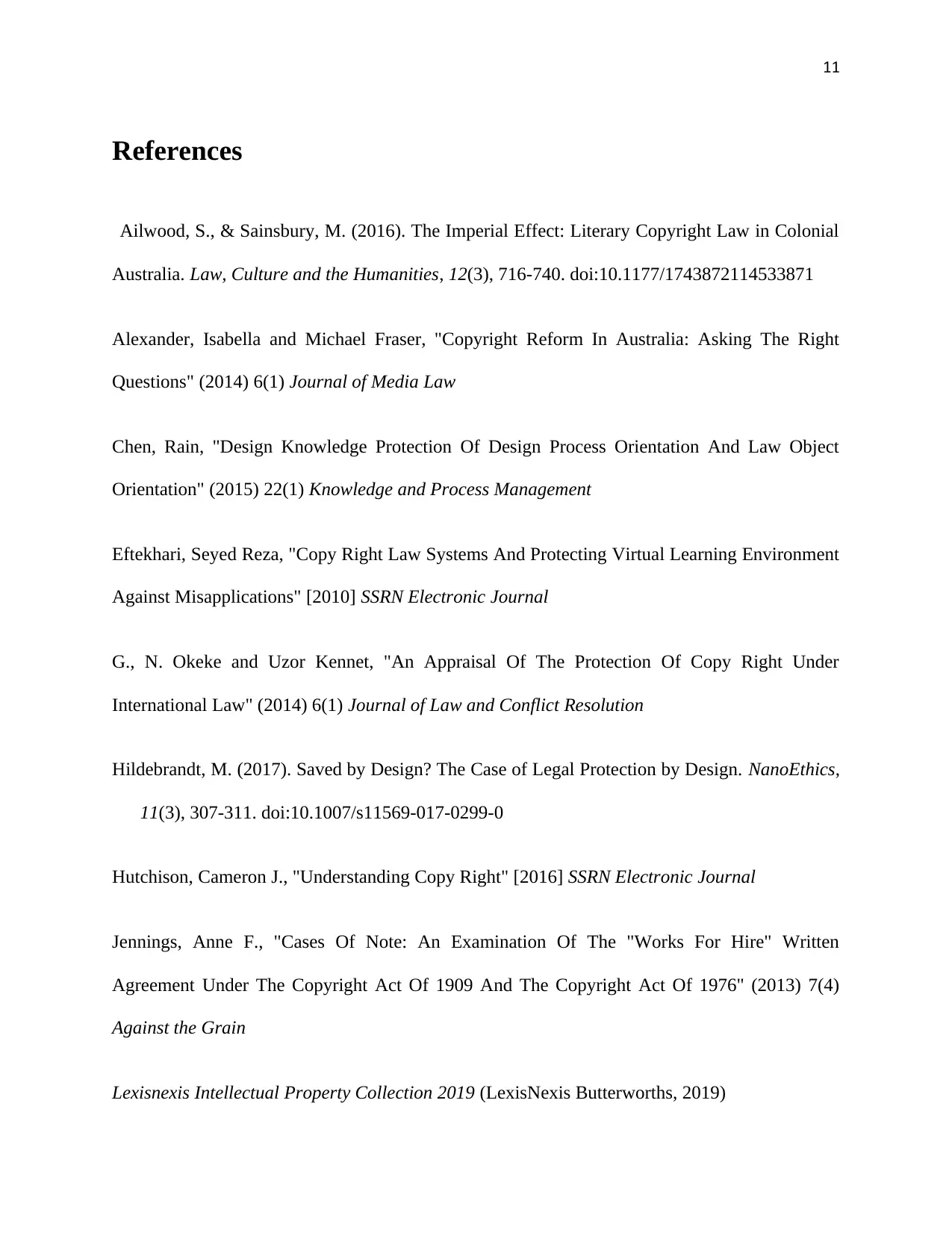
11
References
Ailwood, S., & Sainsbury, M. (2016). The Imperial Effect: Literary Copyright Law in Colonial
Australia. Law, Culture and the Humanities, 12(3), 716-740. doi:10.1177/1743872114533871
Alexander, Isabella and Michael Fraser, "Copyright Reform In Australia: Asking The Right
Questions" (2014) 6(1) Journal of Media Law
Chen, Rain, "Design Knowledge Protection Of Design Process Orientation And Law Object
Orientation" (2015) 22(1) Knowledge and Process Management
Eftekhari, Seyed Reza, "Copy Right Law Systems And Protecting Virtual Learning Environment
Against Misapplications" [2010] SSRN Electronic Journal
G., N. Okeke and Uzor Kennet, "An Appraisal Of The Protection Of Copy Right Under
International Law" (2014) 6(1) Journal of Law and Conflict Resolution
Hildebrandt, M. (2017). Saved by Design? The Case of Legal Protection by Design. NanoEthics,
11(3), 307-311. doi:10.1007/s11569-017-0299-0
Hutchison, Cameron J., "Understanding Copy Right" [2016] SSRN Electronic Journal
Jennings, Anne F., "Cases Of Note: An Examination Of The "Works For Hire" Written
Agreement Under The Copyright Act Of 1909 And The Copyright Act Of 1976" (2013) 7(4)
Against the Grain
Lexisnexis Intellectual Property Collection 2019 (LexisNexis Butterworths, 2019)
References
Ailwood, S., & Sainsbury, M. (2016). The Imperial Effect: Literary Copyright Law in Colonial
Australia. Law, Culture and the Humanities, 12(3), 716-740. doi:10.1177/1743872114533871
Alexander, Isabella and Michael Fraser, "Copyright Reform In Australia: Asking The Right
Questions" (2014) 6(1) Journal of Media Law
Chen, Rain, "Design Knowledge Protection Of Design Process Orientation And Law Object
Orientation" (2015) 22(1) Knowledge and Process Management
Eftekhari, Seyed Reza, "Copy Right Law Systems And Protecting Virtual Learning Environment
Against Misapplications" [2010] SSRN Electronic Journal
G., N. Okeke and Uzor Kennet, "An Appraisal Of The Protection Of Copy Right Under
International Law" (2014) 6(1) Journal of Law and Conflict Resolution
Hildebrandt, M. (2017). Saved by Design? The Case of Legal Protection by Design. NanoEthics,
11(3), 307-311. doi:10.1007/s11569-017-0299-0
Hutchison, Cameron J., "Understanding Copy Right" [2016] SSRN Electronic Journal
Jennings, Anne F., "Cases Of Note: An Examination Of The "Works For Hire" Written
Agreement Under The Copyright Act Of 1909 And The Copyright Act Of 1976" (2013) 7(4)
Against the Grain
Lexisnexis Intellectual Property Collection 2019 (LexisNexis Butterworths, 2019)
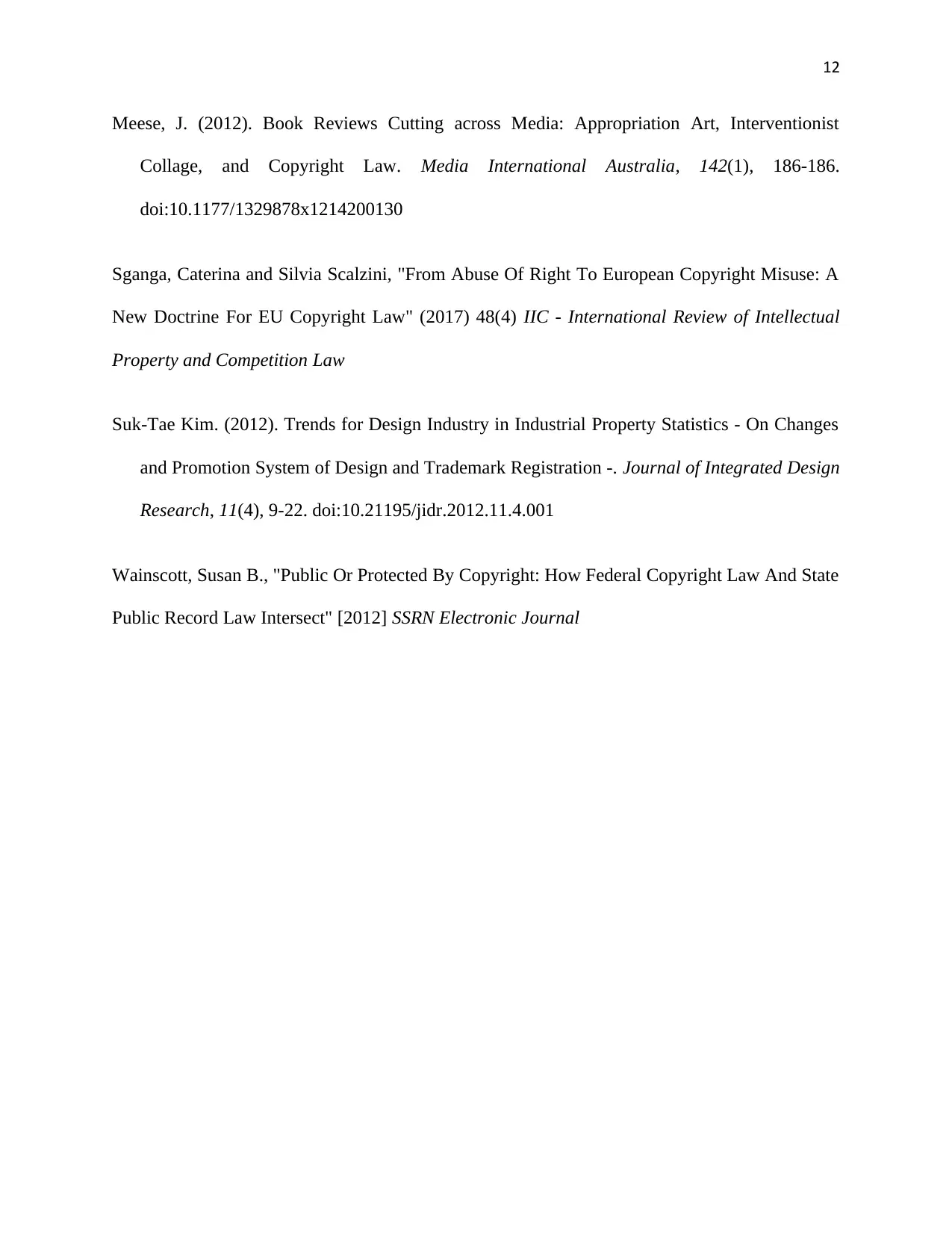
12
Meese, J. (2012). Book Reviews Cutting across Media: Appropriation Art, Interventionist
Collage, and Copyright Law. Media International Australia, 142(1), 186-186.
doi:10.1177/1329878x1214200130
Sganga, Caterina and Silvia Scalzini, "From Abuse Of Right To European Copyright Misuse: A
New Doctrine For EU Copyright Law" (2017) 48(4) IIC - International Review of Intellectual
Property and Competition Law
Suk-Tae Kim. (2012). Trends for Design Industry in Industrial Property Statistics - On Changes
and Promotion System of Design and Trademark Registration -. Journal of Integrated Design
Research, 11(4), 9-22. doi:10.21195/jidr.2012.11.4.001
Wainscott, Susan B., "Public Or Protected By Copyright: How Federal Copyright Law And State
Public Record Law Intersect" [2012] SSRN Electronic Journal
Meese, J. (2012). Book Reviews Cutting across Media: Appropriation Art, Interventionist
Collage, and Copyright Law. Media International Australia, 142(1), 186-186.
doi:10.1177/1329878x1214200130
Sganga, Caterina and Silvia Scalzini, "From Abuse Of Right To European Copyright Misuse: A
New Doctrine For EU Copyright Law" (2017) 48(4) IIC - International Review of Intellectual
Property and Competition Law
Suk-Tae Kim. (2012). Trends for Design Industry in Industrial Property Statistics - On Changes
and Promotion System of Design and Trademark Registration -. Journal of Integrated Design
Research, 11(4), 9-22. doi:10.21195/jidr.2012.11.4.001
Wainscott, Susan B., "Public Or Protected By Copyright: How Federal Copyright Law And State
Public Record Law Intersect" [2012] SSRN Electronic Journal
⊘ This is a preview!⊘
Do you want full access?
Subscribe today to unlock all pages.

Trusted by 1+ million students worldwide
1 out of 12
Related Documents
Your All-in-One AI-Powered Toolkit for Academic Success.
+13062052269
info@desklib.com
Available 24*7 on WhatsApp / Email
![[object Object]](/_next/static/media/star-bottom.7253800d.svg)
Unlock your academic potential
Copyright © 2020–2025 A2Z Services. All Rights Reserved. Developed and managed by ZUCOL.





